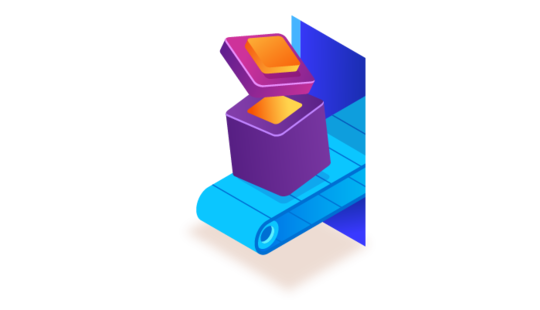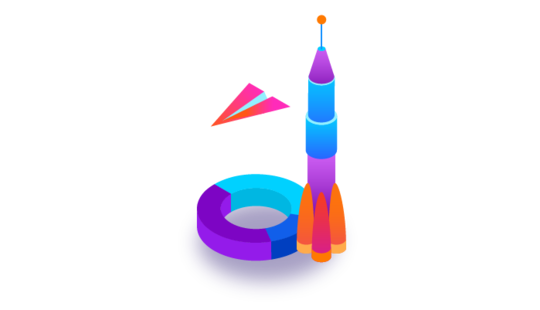-
Product Management
Software Testing
Technology Consulting
-
Multi-Vendor Marketplace
Online StoreCreate an online store with unique design and features at minimal cost using our MarketAge solutionCustom MarketplaceGet a unique, scalable, and cost-effective online marketplace with minimum time to marketTelemedicine SoftwareGet a cost-efficient, HIPAA-compliant telemedicine solution tailored to your facility's requirementsChat AppGet a customizable chat solution to connect users across multiple apps and platformsCustom Booking SystemImprove your business operations and expand to new markets with our appointment booking solutionVideo ConferencingAdjust our video conferencing solution for your business needsFor EnterpriseScale, automate, and improve business processes in your enterprise with our custom software solutionsFor StartupsTurn your startup ideas into viable, value-driven, and commercially successful software solutions -
-
- Case Studies
- Blog
How to create a product vision: A three-step guide with examples
When launching a digital startup, you must make sure you provide your team with a vision they can rely on when making decisions about your product. Though the concept of a product vision seems clear and simple, the process of creating one from scratch is not obvious.
This article provides you with a three-step process for creating a product vision for your digital startup and shares some good examples to follow.
What exactly is a product vision?
A product vision is a statement that describes a product’s purpose and intention and indicates what the product aspires to achieve in the long-term perspective.
The product vision helps to ensure that your team members and stakeholders have a common understanding of the product you’re working on. It answers questions such as why your product exists, who it serves, and what its distinctive features are.
Why does your project need a product vision?
Startups often underestimate the importance of a product vision. However, absence of a product vision or unwillingness to create one may lead to damaging consequences.
If you don’t create a product vision, your team may fail to see your project’s big picture. Your team members won’t see the value in what they’re doing and will struggle to reach a consensus on what tasks are the most important.
In fact, your product vision is the basis for implementing your product idea. Crucial elements of your product development process, such as your product strategy, product roadmap, and product backlog, should be built upon your product vision.
Here, you can see the common sequence of documentation assets created for a digital product development project:

Without a defined product mission, you may struggle with creating an effective product strategy, a compelling product roadmap, and an appropriate backlog.
What are the benefits of a product vision?
Apart from providing a baseline for further development of product documentation, a product vision brings a series of benefits to your project. We’ll review the major ones.
Guides the team’s
When you communicate your product vision to your team, they know precisely what the final product needs to achieve and what value it should bring to end users.
A comprehensive product vision statement sets an ultimate high-level goal for your team that they can rely on when making project decisions.
Helps you prioritize product ideas and features
When selecting features for your product, you can easily get lost among features similar products possess or that your potential customers ask you to implement. The issue is that startups often have resource constraints, and it’s impossible to implement all features straightaway.
A product vision can help you stay focused on your product’s ultimate goal and select features that are indeed essential to test the product’s feasibility.
Keeps the team motivated
Instead of just telling your team members what they need to do, the product vision communicates why what they’re doing is important.
Thus, when performing everyday tasks on a project, team members will be aware of how their work contributes to the project’s purpose. Although some of your employees may not fancy fulfilling their routine tasks, they’ll stay motivated when they feel they’re making a difference.
What are the characteristics of a compelling product vision?
Before we start dealing with the question of how to create a product vision, we’d like to draw your attention to the characteristics of a beneficial product vision. When developing a vision for your own product, make sure it is:
- Aspirational – It should motivate the people involved in your project to devote themselves to accomplishing the product’s purpose.
- Achievable – Although your product vision should be ambitious, it also should be realistic and achievable.
- Customer-focused – Your product vision should consider your target audience’s pain points and needs.
- Concise – Your product statement should be short and to the point.
- Clear – It should be easy to read and understand for everyone engaged in your project.
How to define your product vision?
Since you now understand how crucial the product vision is for your digital startup, we can move on and see how you can create a product vision for your project.
Step #1. Define the product’s purpose
First of all, you need to conduct thorough market research to understand your target audience. Make sure you know your potential customers’ pain points and see what could motivate them to buy your product. Conducting a series of customer research surveys can help you get precise data on this matter.
You also need to research and analyze your competitors’ products to identify what will differentiate your product from similar products on the market and define your product’s unique value proposition.
After conducting research, you can present the results to your team and conduct a brainstorming session with them. During the brainstorming session, you and your team should answer the following questions:
- What is our product?
- What needs of our target audience does this product fulfill?
- How exactly does the product fulfill those needs?
Step #2. Create a product vision board
After conducting research, you need to document the main takeaways about your product offering. A product vision board is a tool that helps you demonstrate major aspects related to your product vision in an easy-to-digest way. Here’s a product vision board template you can use:
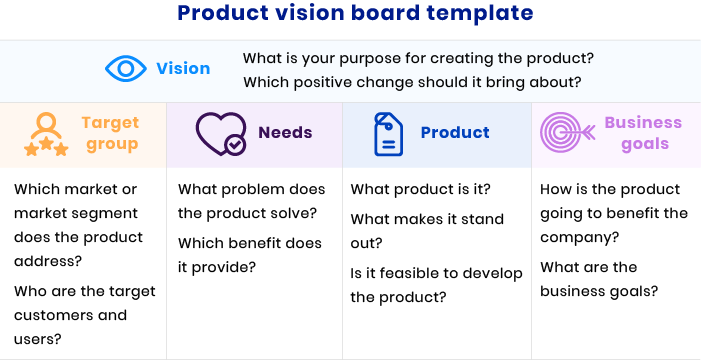
A product vision board consists of several sections, each devoted to a separate aspect of your product idea. Let’s see what information you need to include in each section:
- Vision – In this section, you need to state the ultimate purpose of your digital product, preferably in one inspiring sentence.
- Target group – Here, you should describe the target audience or target audience segment(s) whose needs your product will address.
- Needs – Describe the main problem you will help your customers solve with the help of your product. This section should point out the major reason why your potential customers would want to use your product.
- Product – Jot down three to five key features of your product that you think attract your potential customers the most. These features should align with your product’s unique value proposition.
- Business goals – Here, you can list several benefits you want your digital product to bring to your business.
Below is an example of a filled-in product vision board created for a scheduling app development project:

Step #3. Carry out a product vision workshop
Finally, once you’ve gathered and documented all essential information, you can proceed to developing your product vision statement. To create a vision that will be supported and followed by all your team members and stakeholders, you need to engage key project players in the process of creating the product vision.
A product vision workshop is a team activity that helps you choose the most appropriate vision for your digital product. Here, we’d like to show how you can conduct this workshop:
1. Preparation
First of all, you need to present your research results and a complete product vision board to attendees of the product vision workshop. It would be great if you did this a few days ahead of the workshop so attendees could take their time to get acquainted with the information.
2. Introduction
Inform attendees about the goal of the workshop and provide them with the following template:
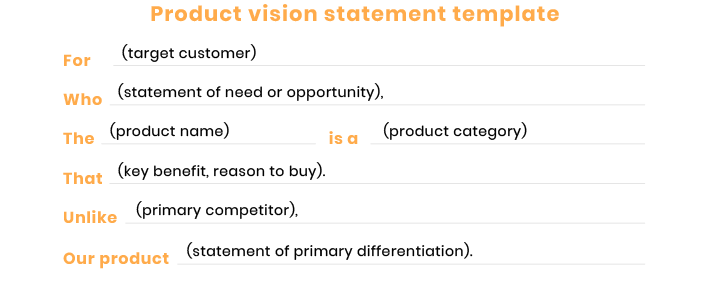
This template helps to emphasize key aspects of your product and present them in a concise way. The last two elements in the template aren’t mandatory, but it’s best to include them to provide everyone engaged in your project with a complete picture of the product.
To make sure everyone understands what information should be included in each part of the template, provide attendees with examples. Below, we present several examples of famous companies’ product vision statements:
Walmart’s product vision is highly user-centered and focused on the unique value proposition Walmart offers:

Netflix aims to become the best global entertainment distribution service, and they mention it in their product vision. It makes their vision ambitious and motivational:

The product vision of Spotify expresses the company’s great purpose and motivates its team members while inspiring users:
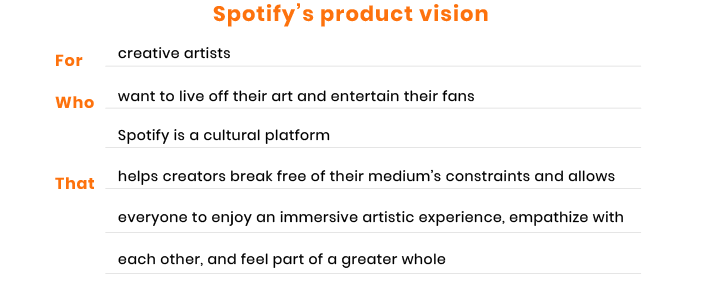
Facebook’s product vision is customer-centric and built upon the desire of their target audience to communicate with their loved ones:
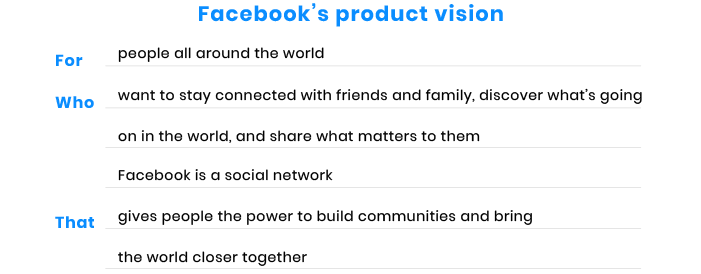
The product vision of LinkedIn corresponds to the image of the company and the network itself and sounds very professional and growth-oriented:

3. Ideation
Offer attendees to fill in the template individually and write the product vision statement they find the most relevant for your product.
4. Presentation
Let each attendee present the statements they have created and explain the reasoning behind them.
5. Voting and reaching consensus
Write down each product vision statement to allow everyone to see them. For this, you can use a whiteboard. Then ask attendees to vote for the vision statements that they think best align with the product’s idea.
The most important thing is to not choose the statement that gets the most votes but to reach a consensus and establish a product vision that every attendee can agree with. For this, you might need to alter or merge some statements.
Conclusion
Remember that a product vision only works effectively when it’s clearly communicated within your team. So make sure all your employees, stakeholders, and other people who play an important role in your project have easy access to your product vision and can freely use it in their work.
FAQ
-
A product vision is a statement that describes the purpose and intention of a product and indicates what the product aspires to achieve in the long-term perspective.
-
- It guides the team
- It helps you prioritize product ideas and features
- It keeps the team motivated
-
You can create a product vision in three easy steps:
- Define the product’s purpose
- Create a product vision board
- Carry out a product vision workshop
If you require assistance with defining your product vision, strategy, and roadmap or if you need help developing your software solution, contact RubyGarage.



